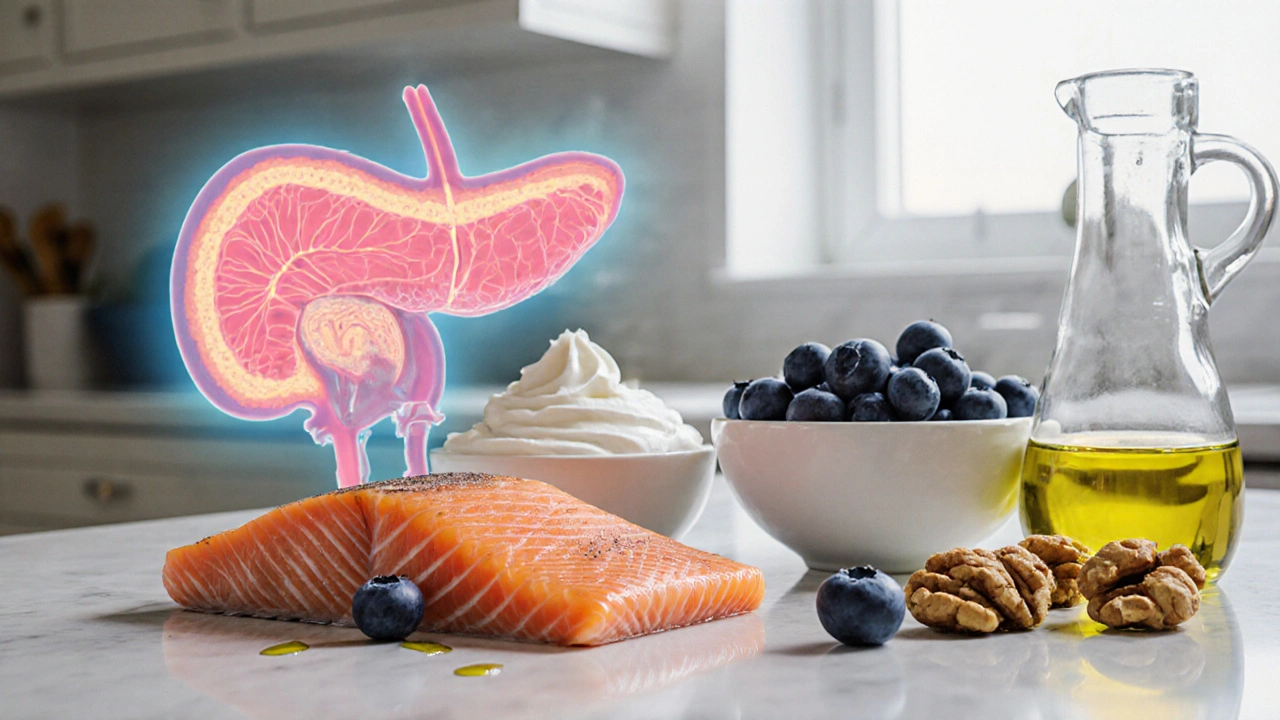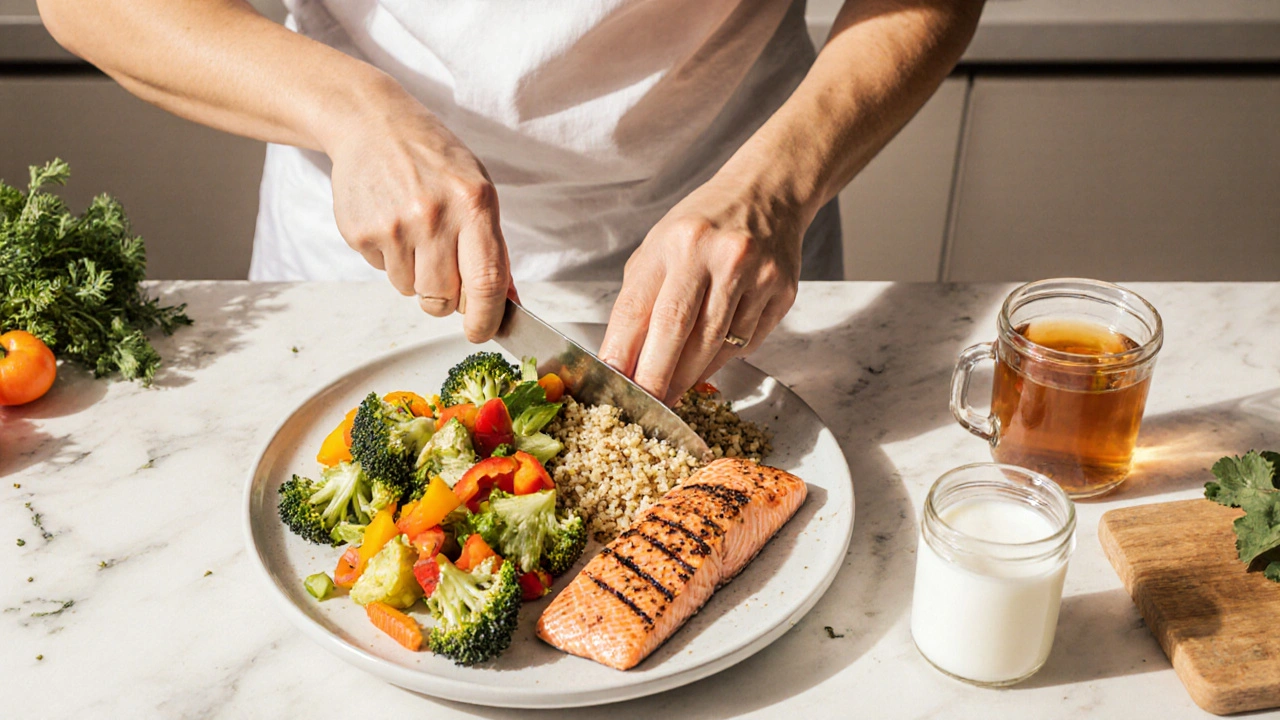How Nutritional Therapy Helps Chronic Pancreatic Inflammation

Key Takeaways
- Targeted nutrition can lower inflammatory markers and ease pain in chronic pancreatic inflammation.
- Choosing the right fats, carbs, and micronutrients supports enzyme production and tissue repair.
- Specific foods - omega‑3‑rich fish, low‑glycemic fruits, probiotic‑laden yogurt - have measurable benefits.
- A personalized plan works better than a generic “low‑fat” diet.
- Regular monitoring with a healthcare professional ensures safety and progress.
When dealing with chronic pancreas issues, nutritional therapy is a personalized dietary approach that aims to reduce inflammation, support organ function, and improve overall wellbeing. It’s not a fad diet; it’s a science‑backed strategy that uses the foods you eat as medicine.
People often ask why food matters for the pancreas. The answer lies in the organ’s role: it releases digestive enzymes and hormones like insulin that regulate blood sugar. When inflammation sticks around, enzyme output falters, blood sugar spikes, and pain becomes chronic. Adjusting what you feed your body can calm the immune response, protect remaining healthy tissue, and give your pancreas a chance to recover.
Understanding Chronic Pancreatic Inflammation
Chronic pancreatic inflammation (often called chronic pancreatitis) is a long‑term condition where the pancreas stays inflamed for months or years. Common causes include heavy alcohol use, gallstones, genetic factors, and repeated attacks of acute pancreatitis. Persistent inflammation leads to scarring, reduced enzyme production, and frequent abdominal pain.
Lab tests typically show elevated C‑reactive protein (CRP) and serum amylase or lipase. Imaging may reveal calcifications or ductal changes. While medication can control pain, the underlying inflammation often needs lifestyle changes to truly improve outcomes.
What Is Nutritional Therapy?
In the context of pancreatic health, nutritional therapy means tailoring macronutrients, micronutrients, and food timing to lower inflammation and support enzyme synthesis. It differs from a “one‑size‑fits‑all” diet by factoring in your medical history, current labs, and personal food preferences.
Key components include:
- Reducing pro‑inflammatory foods (e.g., deep‑fried items, excess saturated fat).
- Introducing anti‑inflammatory nutrients (e.g., omega‑3 fatty acids, antioxidants).
- Balancing carbs to maintain stable blood glucose.
- Adding gut‑supportive elements like probiotics.
- Ensuring adequate vitamins and minerals that the pancreas needs for regeneration.
Anti‑Inflammatory Diets That Help the Pancreas
Several dietary patterns have proven anti‑inflammatory effects. Below are the most research‑backed options for pancreas health.
- Mediterranean diet emphasizes olive oil, fatty fish, nuts, whole grains, and plenty of vegetables. Its high monounsaturated fat content improves lipid profiles and lowers systemic inflammation.
- Low‑fat diet reduces the load on the pancreas by limiting the amount of fat it must emulsify. It’s especially useful after surgery or during flare‑ups.
- Anti‑inflammatory diet focuses on foods rich in polyphenols (berries, turmeric, green tea) and omega‑3s, while cutting refined sugars and processed meats.

Powerful Nutrients and Their Roles
Below are the top nutrients that directly impact pancreatic inflammation.
| Nutrient | Primary Benefits | Food Sources |
|---|---|---|
| Omega‑3 fatty acids | Reduces inflammatory cytokines (IL‑6, TNF‑α); improves membrane fluidity of pancreatic cells. | Salmon, mackerel, chia seeds, walnuts. |
| Probiotics | Modulates gut microbiota, lowers endotoxin leakage that can trigger pancreatic inflammation. | Greek yogurt, kefir, sauerkraut, fermented miso. |
| Vitamin D | Immune regulation; deficiency linked to higher CRP levels. | Fortified dairy, mushrooms exposed to UV light, sunlight exposure. |
| Magnesium | Supports enzymatic reactions and reduces oxidative stress. | Leafy greens, almonds, black beans. |
| Vitamin C | Antioxidant that neutralizes free radicals generated during inflammation. | Citrus fruits, bell peppers, strawberries. |
Putting It All Together: Sample Daily Plan
Below is a practical, 7‑day rotation that blends the Mediterranean and anti‑inflammatory principles while keeping the pancreas comfortable.
- Breakfast: Overnight oats made with almond milk, topped with blueberries, a tablespoon of ground flaxseed, and a dollop of Greek yogurt (probiotic boost).
- Mid‑morning snack: A handful of walnuts (omega‑3) and a small orange (vitamin C).
- Lunch: Grilled salmon over quinoa, steamed broccoli, and a drizzle of extra‑virgin olive oil. Sprinkle with pumpkin seeds for magnesium.
- Afternoon snack: Carrot sticks with hummus (low‑fat, high‑fiber).
- Dinner: Chicken breast cooked in a tomato‑basil sauce, served with roasted sweet potatoes and a side salad of mixed greens, avocado, and lemon vinaigrette.
- Evening: A cup of chamomile tea and a small piece of dark chocolate (70%+ cacao) for antioxidants.
Adjust portion sizes to match your caloric needs and avoid large, heavy meals that force the pancreas to release a flood of enzymes.
When to Seek Professional Guidance
Even the best‑designed food plan can backfire if underlying conditions aren’t considered. Look for these red flags:
- Persistent abdominal pain despite dietary changes.
- Unexplained weight loss or malnutrition signs.
- Blood sugar spikes that raise concern for diabetes.
- Elevated liver enzymes or pancreatic enzyme insufficiency.
If any of these appear, schedule a follow‑up with a gastroenterologist or a registered dietitian trained in pancreatic disorders. They can order enzyme panels, imaging, and tailor the nutrition plan further.

Common Pitfalls and How to Avoid Them
Even motivated patients can slip into habits that negate the benefits of nutritional therapy. Here are three frequent mistakes and quick fixes:
- Over‑relying on “low‑fat” alone. Removing all fats can lead to deficiencies in essential fatty acids. Balance low‑fat meals with omega‑3 sources.
- Skipping meals. Long gaps cause blood‑sugar crashes, prompting the pancreas to over‑compensate. Aim for 4-5 small meals a day.
- Ignoring hydration. Dehydration concentrates digestive enzymes and intensifies pain. Drink at least 2L of water daily, sipping throughout meals.
Tracking Progress: Simple Metrics
Quantifying improvement helps keep motivation high. Record these weekly:
- Pain level on a 0‑10 scale (morning vs evening).
- Stool consistency using the Bristol Stool Chart (aim for Type 3‑4).
- Weight and body‑mass index (BMI) - avoid rapid loss.
- Blood glucose fasting value (target 70‑99mg/dL).
- CRP level (if your doctor orders it) - look for a downward trend.
Sharing these numbers with your dietitian lets you fine‑tune the plan in real time.
Frequently Asked Questions
Can I follow a pancreatic diet if I’m not diagnosed with chronic pancreatitis?
Yes. The anti‑inflammatory principles work for anyone looking to reduce systemic inflammation, support gut health, and maintain stable blood sugar. However, if you have no pancreas‑related issues, you may not need the strict low‑fat restriction.
Do pancreatic enzyme supplements replace the need for a special diet?
Enzyme supplements help digestion, but they don’t address the root cause of inflammation. Pairing supplements with nutritional therapy yields the best symptom relief and long‑term tissue recovery.
Is alcohol completely forbidden on a pancreatic diet?
For most patients with chronic pancreatic inflammation, abstaining from alcohol is strongly advised because even small amounts can trigger flare‑ups and worsen scarring.
How long does it typically take to notice a reduction in pain?
Most people report milder discomfort within 2‑4 weeks of consistent dietary changes, but full healing can take several months, especially if fibrosis is advanced.
Are there any foods I should avoid forever?
Highly processed meats, deep‑fried snacks, sugary sodas, and large portions of saturated butter are best limited indefinitely. Individual tolerances may vary, so keep a food diary.
Stephanie Zuidervliet
October 12, 2025 AT 17:40Oh my gosh!!! This deep dive into pancreatic nutrition is everything!!! The sheer detail about omega‑3s, probiotics, and magnesium makes me feel like I finally have a roadmap to soothe my chronic pain!!! I’m practically shaking with excitement!!!
Olivia Crowe
October 12, 2025 AT 17:45It’s amazing how just a few tweaks-like swapping butter for olive oil and adding a daily serving of yogurt-can turn the tide on inflammation. Stay hopeful, you’ve got this!
Aayush Shastri
October 12, 2025 AT 17:50In many Indian kitchens, we already use turmeric and mustard seeds, which are rich in anti‑inflammatory compounds. Pairing those spices with a modest portion of fatty fish can create a powerful blend that supports pancreatic healing while honoring tradition.
Quinn S.
October 12, 2025 AT 17:55While the presented dietary regimen is comprehensive, certain statements lack precise citation; for instance, the claim that “vitamin D deficiency is linked to higher CRP levels” requires peer‑reviewed evidence. Moreover, the phrase “low‑fat diet reduces the load on the pancreas” should be qualified with quantitative data to avoid ambiguity.
Dilip Parmanand
October 12, 2025 AT 18:00Start small-add a handful of walnuts to your morning oatmeal and notice the difference in energy and pain levels within days.
Sarah Seddon
October 12, 2025 AT 18:05Picture this: a bright sunrise over a calm sea, and you, sipping a chia‑seed infused smoothie, feeling the inflammation melt away like ice under the sun. That’s the power of a nutrient‑rich plan-vibrant, bold, and absolutely life‑changing! Keep pushing, champion!
Ari Kusumo Wibowo
October 12, 2025 AT 18:10Look, everyone’s got an opinion, but the real win is finding what actually works for you without getting tangled in diet wars. Mix the Mediterranean staples with your personal preferences, and the pancreas will thank you later.
Hannah Gorman
October 12, 2025 AT 18:15When evaluating any nutritional protocol, especially one targeting a complex organ like the pancreas, it is essential to adopt a holistic perspective that transcends mere calorie counting. First, one must recognize that chronic inflammation is not a singular pathway but a network of cytokines, oxidative stressors, and gut‑microbiome interactions. Second, the role of dietary fats extends beyond the simplistic “low‑fat” mantra; essential fatty acids, particularly EPA and DHA, serve as precursors to resolvins that actively resolve inflammation. Third, the timing of meals influences pancreatic enzyme secretion, with smaller, frequent meals mitigating the abrupt enzymatic surge that can exacerbate pain. Fourth, the synergistic effect of probiotics and prebiotic fibers creates a barrier against endotoxin translocation, thereby reducing systemic inflammatory markers. Fifth, micronutrients such as magnesium and zinc act as cofactors for over thirty enzymatic reactions, many of which are directly involved in cellular repair processes within pancreatic tissue. Sixth, patient adherence is invariably linked to palatability and cultural relevance, so any plan that disregards regional food preferences is doomed to failure. Seventh, regular monitoring of objective metrics-CRP, fasting glucose, and stool consistency-provides the feedback loop necessary to fine‑tune the diet in real time. Eighth, interdisciplinary collaboration between gastroenterologists, dietitians, and mental health professionals ensures that both physiological and psychosocial dimensions are addressed. Ninth, the psychological burden of chronic pain can itself perpetuate inflammation, highlighting the need for stress‑reduction techniques alongside dietary changes. Tenth, omega‑3 supplementation alone, without concurrent dietary adjustments, yields modest benefits at best. Eleventh, the inclusion of antioxidant‑rich foods such as berries and leafy greens combats oxidative damage that otherwise accelerates fibrosis. Twelfth, excessive reliance on “magic bullet” supplements can obscure the fundamental importance of whole‑food nutrition. Thirteenth, clinicians must remain vigilant for signs of malabsorption, which can emerge silently as weight loss or nutrient deficiencies. Fourteenth, hydration status directly impacts enzyme concentration, making adequate water intake a non‑negotiable component of any plan. Fifteenth, while the literature supports anti‑inflammatory diets, individual variability means that trial and error remains a cornerstone of personalized therapy. Finally, embracing a patient‑centered approach that respects autonomy while providing evidence‑based guidance ultimately yields the most sustainable outcomes for those battling chronic pancreatic inflammation.
Tatiana Akimova
October 12, 2025 AT 18:20Don’t wait for the pain to dictate your life-grab those omega‑3s, schedule your meals, and dominate your pancreas health today!
Calandra Harris
October 12, 2025 AT 18:25America’s diet standards are the only ones that truly cut inflammation
Dan Burbank
October 12, 2025 AT 18:30One must concede that the presented protocol, though ostensibly comprehensive, borders on the pedestrian in its neglect of phytonutrient diversity. A truly erudite regimen would intertwine flavonoid‑rich coumarins with curcumin‑laden turmeric, thereby orchestrating a symphony of anti‑inflammatory pathways seldom achieved by mere fish and olive oil. Shall we settle for mediocrity?
Anna Marie
October 12, 2025 AT 18:35I appreciate the thoroughness of this guide and would add that maintaining a food diary can greatly enhance communication with your healthcare team, ensuring that adjustments are both evidence‑based and personally resonant.
Miriam Bresticker
October 12, 2025 AT 18:40i think the pancreas is like a secret engine, kinda hidden but sooo vital 😊 if u feed it right the whole body feels like a sunrise 🌅 but omg sometimes i forget and eat junk lol 🙈 #foodforthought
Claire Willett
October 12, 2025 AT 18:45Implementing macro‑balanced macronutrient ratios improves glycemic control and reduces pancreatic exocrine demand.
olivia guerrero
October 12, 2025 AT 18:50You’re on the right track!!! Keep those omega‑3 bites coming and watch the inflammation melt away!!! Consistency is key!!! 🌟
Dominique Jacobs
October 12, 2025 AT 18:55Ever wonder why some folks swear by fermented foods while others skip them? Try adding a spoonful of kefir to your breakfast smoothie and see if your gut vibes change – the results might just surprise you!
Claire Kondash
October 12, 2025 AT 19:00Contemplating the pancreas is akin to pondering the hidden gears of a clock that governs our very existence; each enzyme a tiny messenger, each secreted hormone a whisper of metabolic harmony. When inflammation clouds this delicate machinery, the body’s equilibrium tilts, prompting us to seek refuge in the foods we choose. The ancient Ayurvedic notion of “agni” – digestive fire – mirrors modern science’s emphasis on enzyme health, suggesting that fire can be kindled not only by spices but also by omega‑rich fish and probiotic cultures. In this light, a Mediterranean plate is not merely a culinary delight but a therapeutic canvas upon which we can repaint our internal landscape. Moreover, the act of mindful eating, where we savor each bite, may calibrate the nervous system, reducing stress‑induced cortisol spikes that further inflame pancreatic tissue. Thus, nutrition transcends sustenance; it becomes a dialogue between gut microbes, immune cells, and our conscious intent. 🍽️💡 As we document our meals, track pain scores, and adjust macros, we engage in a form of self‑experimental alchemy, turning ordinary ingredients into agents of repair. The journey is neither swift nor linear, but each small victory – a calmer abdomen after breakfast, a steadier blood sugar after lunch – signals progress. Let us honor this process with patience, curiosity, and an open heart, for the pancreas, though hidden, responds to the love we pour into our plates. 🌱✨
Matt Tait
October 12, 2025 AT 19:05Honestly, if you’re still munching on fried chicken while preaching anti‑inflammation, you’re missing the point entirely – quit the junk and stop preaching!
Benton Myers
October 12, 2025 AT 19:10Interesting overview of diet’s role in pancreatic health.